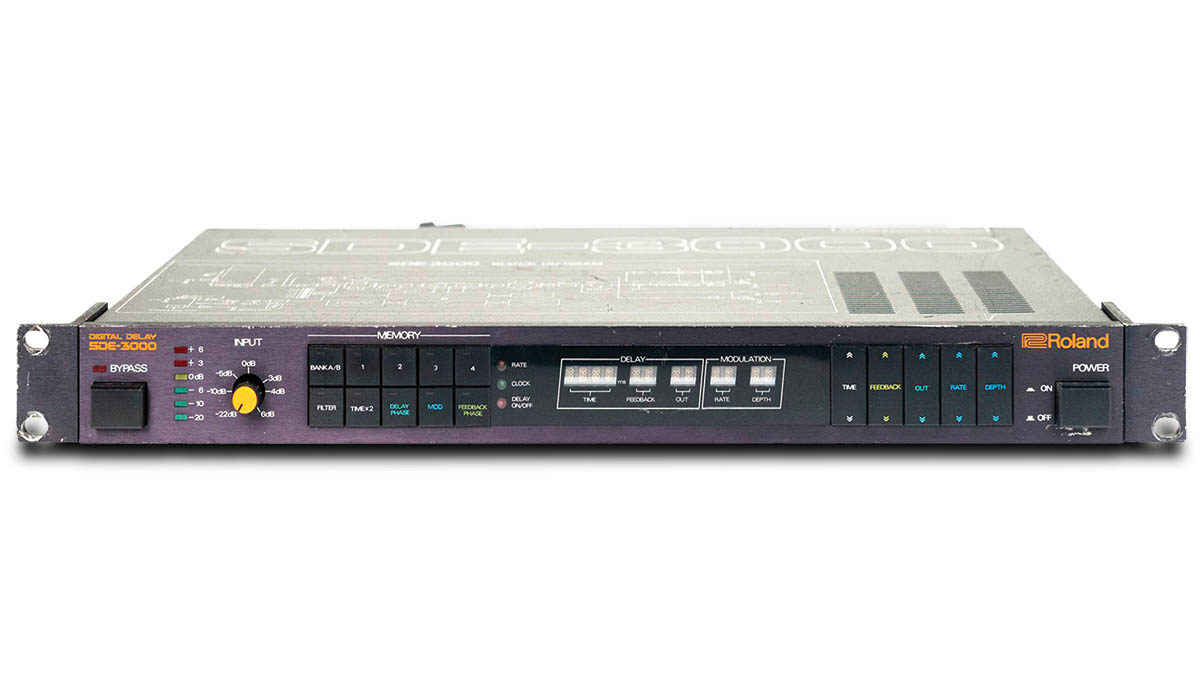A staple of Eddie Van Halen, Steve Vai and Steve Lukather’s ‘80s live rigs, the Roland SDE-3000 was a game-changer for digital delay
Recently reissued in pedal form, the SDE-3000 was more than just a delay unit. Combining modulation with musical, organic repeats, it was the secret sauce in many a pro player’s live rig and studio setup

Digital technology for musicians has advanced significantly since the first relatively affordable digital delays emerged in the early ’80s. So why have so many studios and guitarists refused to give up their Roland SDE-3000 rackmount units, which came out 40 years ago in 1983?
The SDE-3000 remained a permanent fixture in the stage racks of Eddie Van Halen and Steve Vai from 1985 onwards, and it instantly became a legendary effect found in Bob Bradshaw racks built for studio guitarists Steve Lukather, Michael Landau and Dann Huff.
World class producer/engineer/mixer Bob Clearmountain still frequently uses the 3000 on vocal recordings, and Eric Clapton, Neil Young and dozens of other pros have relied upon the 3000 at various stages of their careers.
After the model’s discontinuation in 1985 when Roland released the “new and improved” SDE-2500 with 64 presets and MIDI, demand for the 3000 grew so significantly over the years that Roland reissued it in the early ’90s as the SDE-3000A, which was identical in every way… except for the “A” on the front panel.
By today’s standards, the SDE-3000 is primitive, but back in 1983 it was state-of-the-art and carried a hefty price tag of $1,099 (about $3,350 today adjusted for inflation). Its proprietary 63H101 CMOS gate array IC and 12-bit analog-to-digital converters, companded to 16-bit performance, delivered a maximum frequency range of 10Hz to 17kHz.
Despite having specs that seem ho-hum today, the SDE-3000 sounds remarkably smooth, pristine and musical, which is the reason for its perennial success rather than the usual gritty, grungy lo-fi nostalgia for early digital effects.
Wet/dry/wet spacious “reverb”
Left unit Time: 400, Feedback: 20
Out: 30, Rate: 00, Depth: 00
Right unit Time: 800, Feedback: 15
Out: 30, Rate: 00, Depth: 00
This setup requires three separate amps and cabinets,
with the dry (no delay) signal going to the center amp
and the 3000’s Mixed outputs going to respective
left and right amps.
Chorus
Time: 25, Feedback: 00, Out: 65, Rate: 40, Depth: 99;
Filter, Delay Phase and Mod buttons engaged
A significant factor of the 3000’s appeal to guitarists is that Roland’s Yoshi Ikegami, who designed the original unit, was a guitarist himself, so he tweaked the circuit and selected components partly based on how well they worked for electric guitar. Certain technical imperfections, like its inaccurate sampling rate clock, also make the delays sound more organic than the robot-like perfection of today’s sophisticated units.
Get The Pick Newsletter
All the latest guitar news, interviews, lessons, reviews, deals and more, direct to your inbox!
Features of the SDE-3000 include a maximum delay time of 1500ms at full fidelity, which could be doubled to 3000ms with a front panel 2x button that halved the sampling rate and reduced its high frequency response to 8kHz. A 1.5x Delay Time knob on the rear expanded delay times to 2250ms (full frequency) or 4500ms (8kHz peak), but using it disengaged the modulation section.
Users could program chorus, flanging and vibrato effects with the modulation section’s rate and depth controls (triangle wave modulation only), greatly assisted by the ability to precisely program delay times in 0.1ms increments from 1 to 10ms and 1.0ms increments from 10 to 1500ms.
Other cool features include a Filter button that engages lo- and high-cut filter EQ settings that generate warmer, darker echo-style repeats, a Hold function that engages infinite repeats (for primitive looper applications), and the wonderfully named Playmate function – a very early tap tempo feature where the first tap reset delay time to zero, the second tap started the clock and the third stopped it.
Eight presets store delay time, feedback and output settings plus modulation rate and depth, and users can scroll through presets with a footswitch.
The Boss DD-2 and early iterations of the DD-3 contain the same 63H101 IC “long chip,” but while some say they’re basically an SDE-3000 in a stomp box, many of the 3000’s key features like modulation are missing, and the shorter maximum delay time and lower 10Hz to 8kHz frequency response aren’t as impressive.
The newly announced Boss SDE-3000D and SDE-3000EVH are truly an SDE-3000 (actually two of them) in a stompbox, meticulously designed by an expert team of pros with golden ears to perfectly duplicate the original unit’s sound and elusive musical je ne sais quoi.
Chris is the co-author of Eruption - Conversations with Eddie Van Halen. He is a 40-year music industry veteran who started at Boardwalk Entertainment (Joan Jett, Night Ranger) and Roland US before becoming a guitar journalist in 1991. He has interviewed more than 600 artists, written more than 1,400 product reviews and contributed to Jeff Beck’s Beck 01: Hot Rods and Rock & Roll and Eric Clapton’s Six String Stories.
“Sonically excellent… we found that it could be a viable substitute for our vintage 1970s pedals”: Hamstead x That Pedal Show Redwing Analogue Stereo Modulator review
“The original Jordan Boss Tone was probably used by four out of five garage bands in the late ’60s”: Unpacking the gnarly magic of the Jordan Boss Tone – an actual guitar plug-in that delivers Dan Auerbach-approved fuzz





![John Mayer and Bob Weir [left] of Dead & Company photographed against a grey background. Mayer wears a blue overshirt and has his signature Silver Sky on his shoulder. Weir wears grey and a bolo tie.](https://cdn.mos.cms.futurecdn.net/C6niSAybzVCHoYcpJ8ZZgE.jpg)

![A black-and-white action shot of Sergeant Thunderhoof perform live: [from left] Mark Sayer, Dan Flitcroft, Jim Camp and Josh Gallop](https://cdn.mos.cms.futurecdn.net/am3UhJbsxAE239XRRZ8zC8.jpg)




